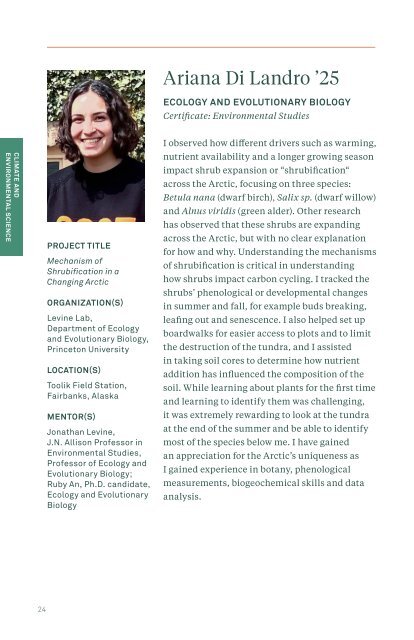Environmental Internship Program - 2023 Booklet
Create successful ePaper yourself
Turn your PDF publications into a flip-book with our unique Google optimized e-Paper software.
Ariana Di Landro ’25<br />
ECOLOGY AND EVOLUTIONARY BIOLOGY<br />
Certificate: <strong>Environmental</strong> Studies<br />
CLIMATE AND<br />
ENVIRONMENTAL SCIENCE<br />
PROJECT TITLE<br />
Mechanism of<br />
Shrubification in a<br />
Changing Arctic<br />
ORGANIZATION(S)<br />
Levine Lab,<br />
Department of Ecology<br />
and Evolutionary Biology,<br />
Princeton University<br />
LOCATION(S)<br />
Toolik Field Station,<br />
Fairbanks, Alaska<br />
MENTOR(S)<br />
Jonathan Levine,<br />
J.N. Allison Professor in<br />
<strong>Environmental</strong> Studies,<br />
Professor of Ecology and<br />
Evolutionary Biology;<br />
Ruby An, Ph.D. candidate,<br />
Ecology and Evolutionary<br />
Biology<br />
I observed how different drivers such as warming,<br />
nutrient availability and a longer growing season<br />
impact shrub expansion or “shrubification“<br />
across the Arctic, focusing on three species:<br />
Betula nana (dwarf birch), Salix sp. (dwarf willow)<br />
and Alnus viridis (green alder). Other research<br />
has observed that these shrubs are expanding<br />
across the Arctic, but with no clear explanation<br />
for how and why. Understanding the mechanisms<br />
of shrubification is critical in understanding<br />
how shrubs impact carbon cycling. I tracked the<br />
shrubs’ phenological or developmental changes<br />
in summer and fall, for example buds breaking,<br />
leafing out and senescence. I also helped set up<br />
boardwalks for easier access to plots and to limit<br />
the destruction of the tundra, and I assisted<br />
in taking soil cores to determine how nutrient<br />
addition has influenced the composition of the<br />
soil. While learning about plants for the first time<br />
and learning to identify them was challenging,<br />
it was extremely rewarding to look at the tundra<br />
at the end of the summer and be able to identify<br />
most of the species below me. I have gained<br />
an appreciation for the Arctic’s uniqueness as<br />
I gained experience in botany, phenological<br />
measurements, biogeochemical skills and data<br />
analysis.<br />
24
















